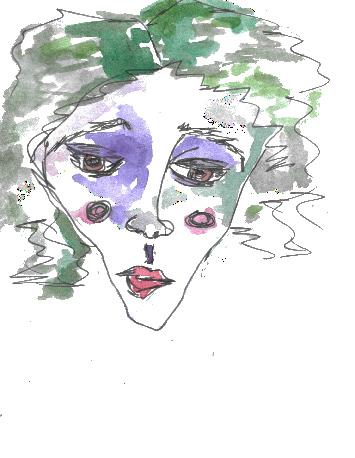
6 minute read
Head in the Clouds


Advertisement
Living with anxiety is not what I thought it would be. I remember being in middle school and hearing about anxiety and depression from the school guidance counselor, health class, even social media and thinking that anxiety was probably nothing. It could not possibly be as bad as people made it out to be—at least, not much worse than the stress and pressure I was used to experiencing every day. I never considered the fact that I might be struggling with anxiety until much later, and even now, I find myself doubting the reality I’m in, believing I must have invented it somehow. Whether I created it or not, however, I do not understand it—why it persists, even now that the pressures I faced in childhood have mostly been alleviated.

I like to imagine my fears are like clouds. Some of them, I can see right through, and others require me to lie down and stare into the sky before they reveal to me what they really are. But sometimes, the clouds cover the sun, leaving my world cold and dark as I urge them to pass.
Oftentimes, when someone asks me what my sky looks like, I don’t have an answer for them. In these moments, my anxiety invades and it is as if all the clouds in the universe have been pushed together so tightly that they will never part, as if no single cloud can be removed, and I will never know what lies behind them. Panic rises
By Kendall Rosevelt
within me—I am lost in the clouds, yet I cannot distinguish a single one. My vision is blurry; my eyes dart throughout the sky, searching for any explanation, any way out of this inescapable fog. Am I stressed about my classes? Am I anxious about a friend? Am I frustrated with a family member? I suddenly wish I were—because which is worse, to feel overwhelmed about something concrete that I can change or to acknowledge that right now, I can’t answer that question? Or furthermore, that the answer to that question has grown into something so daunting that it would be better to live with the ambiguity of my surroundings than to think about it for a second longer?
So when someone asks me what my sky looks like, I describe to them a translucent cloud—one that can be easily dispelled. I avert my eyes from the sky and try to direct my vision elsewhere. I’m pretty good at looking off in this way; the clouds stay in the sky, and I stay on the ground. But sometimes my clouds don’t stay in the sky—sometimes, they sink down until they meet me where I am, and they smother the earth around me.
My fears are often doubts, and when I am feeling especially frustrated, I wonder who I could be without them. When my entire world is covered in a thick fog, how am I to know where to go? What am I to do but search for any point in the distance and follow it? When the fog
becomes too thick and the clouds, too dense, when I cannot help but doubt any decision I make, I look. I look for anyone or anything to tell me what I should do or how I can do better or that I am finally doing what I am supposed to.
And once I do that, all I have to do is watch the world around me. I watch my body carry me through the fog, as it does what it is told to. The mundanity of these days allows my eyes to adjust to the haze and the clouds to become part of the background. For a couple of days, usually less, this works just fine, but there always comes a point when the clouds refuse to be ignored. I start to notice them not just covering the sky, but blocking the light from shining through. They convince me that the background I am used to is a lie, that they are the one reality I can perceive clearly enough to trust.
I want to see the world the way that my friends do—where the clouds stay in the sky, the air around me is free of smog, and with every glance, I see the world’s true colors. A clear sky and a sunny day is all I really need, but I can’t control the weather.
Often, I find that the narrative surrounding anxiety is that one can combat it—destroy it, even—if one can just find the irrationality in their fears. From the advice of my closest friends to that of my psychiatrist, there does not seem to be a solution more advanced than that. A few cognitive strategies remove some clouds, and pills make them less dense, but there are no magic glasses that show me what my world really looks like.
In the absence of a solution, I have realized why anxiety disorders are such a debilitating illness. For so many years, I dealt with my anxiety by waiting for it to be resolved—when the clouds don’t exist anymore, I thought, these feelings will be gone. From childhood until high school, I waited for my soccer and basketball seasons to end—I counted down the minutes until nearly every practice and game would finish. I waited for the school day to be over, for test dates to pass, for my acceptance letter from Michigan. I waited for adulthood, when I would finally have a better relationship with my dad, or, if not, when I wouldn’t have to live with him. I waited for a world where there would finally be nothing for me to worry about, and I fully believed this world existed. Sometimes I still do.
After spending years upon years waiting for my “one day,” I realized that that day will never come. When the issues I was once so accustomed to dealing with disappeared from my daily life and I was presented with a set of new ones, it became clear to me that I was not just a “worrier.” I could no longer organize the clouds into their normal categories: school, sports, friends, boyfriend, dad. I couldn’t simply wait for them to pass.
I have learned, since then, how to see the light shine through the clouds. Sometimes, this means seeing a brighter alternative to my fears, but most often, I find that it is seeing the brightness in my life today. It is a special feeling, really, to know that the people in my life can become the sunlight I need and burn right through the clouds and the fog. It is breathtaking and stomach-churning to feel their gentle warmth, their nurturing light—to feel myself growing. It’s like my heart is buried deep underground—my mind, lost in the thickest fog—and this light carries me up, a glimmer closer to how I know I am supposed to feel.
Surviving anxiety has taught me that the sun shines every day, but the clouds just get in its way. You can’t harness the sunlight to break through every cloud, and there is no special formula for being able to see it. Surviving anxiety is hard— way harder than I ever thought it would be—but I am able to find peace in the fact that while I can’t control the weather, it also can’t control me. 17










